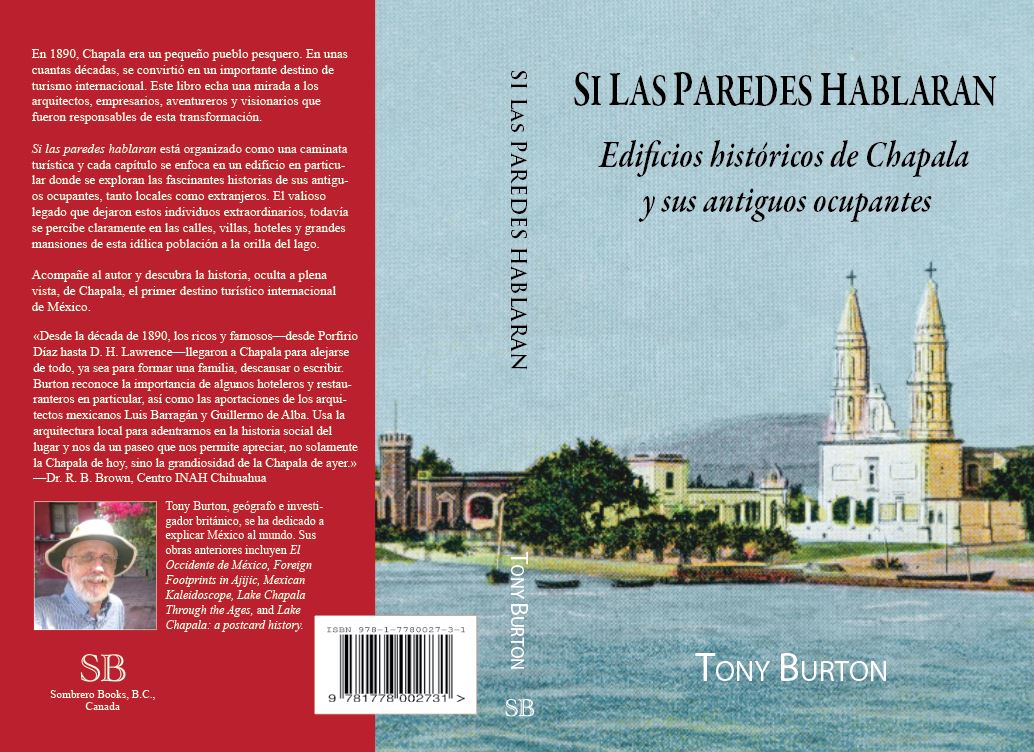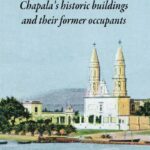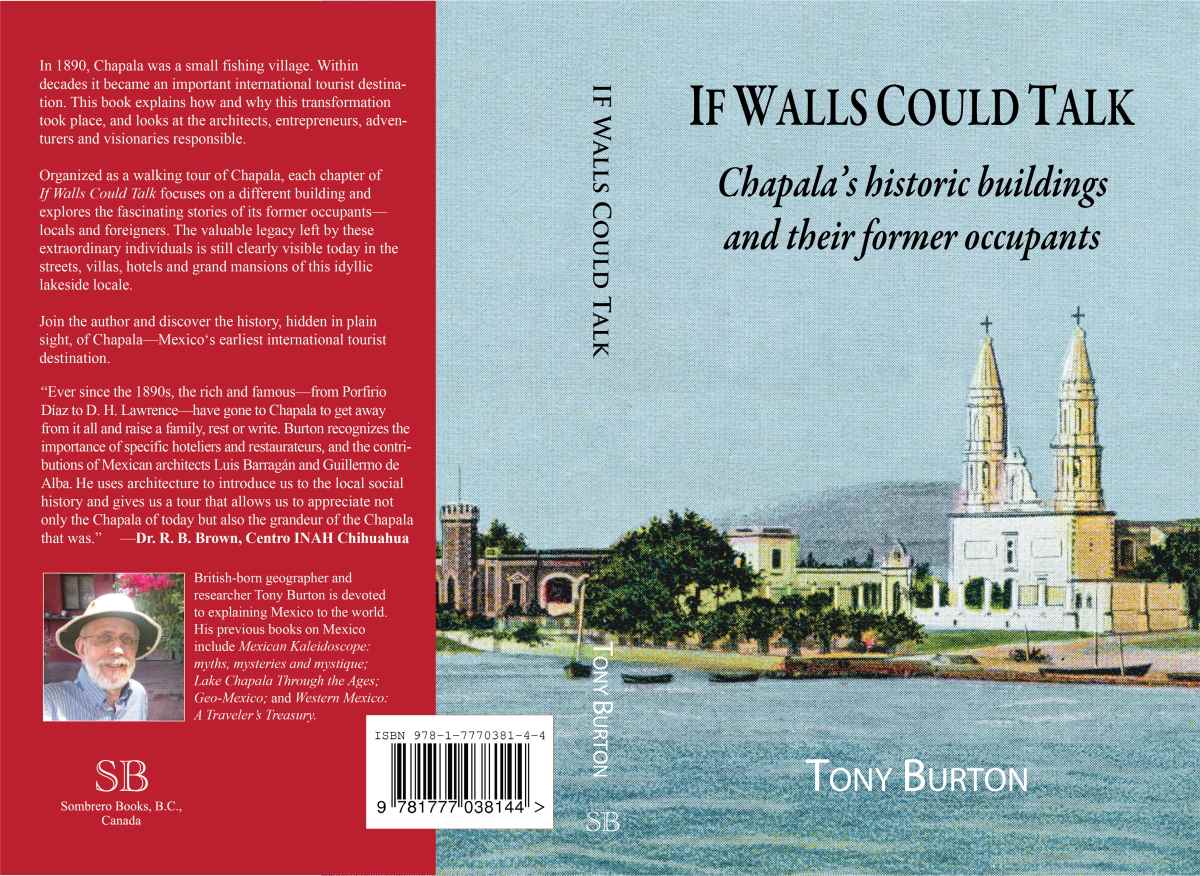These revisions and additions (September 2025) apply primarily to books purchased in Mexico. Books purchased more recently via Amazon are the latest printing at the time of purchase (check for any later revisions); Kindle editions should automatically update whenever minor revisions are made.
page 14, para 5 – should be Maldonnat
page 39, para 1 – should read: … building. Some rooms were in use in 1897; the hotel opened formally in March 1898.
page 53, para 2 – should read: …at about the time Schjetnan, now divorced, left Chapala . . .
page 85, line 11 – should be Eduard
page 87, final para -should read: acquired in 1956 by Dr. Salvador Urzúa and his wife, Estela.
Previous revisions (December 2024)
page 1, para 1: should read “. . . natural lake, and hemmed in by two haciendas, Hacienda del Cuije to the west and Hacienda de la Labor to the east, was attracting . . .”
page 7, last para, line 1: should read “The current eclectic Parroquia …”
page 28, para 2: should read “in 1938”
page 43, para 2: should read: “Things picked up after 1918 when. . . ”
page 55, para 3, last sentence: should read “1908”
page 56, para 4: Opening sentence should read: “In 1906, while working for the Guadalajara city council, de Alba directed the project to create Colonia Moderna, which integrated homes and light industry into a new colonia with wide streets and modern infrastructure.”
page 56, para 5: should read “The following year, de Alba started building his own family home—Mi Pullman (1908)—in Chapala. He also completed the Hotel Palmera (1907), Villa Niza (c. 1919), and the Chapala Railroad Station (1920).”
page 101, line 2: should read “1897”
page 112, caption: should read “c. 1938.”
page 129, last line: should read “northern side of Paseo Ramón Corona (which had been proposed, but not yet built) from the lake.”
page 134, lines 1-2: should read “in 1903, before its construction began.”
page 175 : entry dated 1906 (Guillermo . . .) should be dated “1908” and appear after entry dated 1907.
page 176: entry for pages 30 (lower), 44,etc: should read “courtesy of family of Jesús González Miranda.”
Previous revisions (April 2023)
page 16: Villa Ana Victoria “c. 1905″ should be “c. 1897″
page 41: figures for inheritance values are in pesos. [exchange rate at the time was 2 pesos to a US dollar]
page 45: Musician Mike Laure’s former home (Acapulco 30) is now a museum in his honor.
page 56: “Rafael de la Mora (Villa Carmen)” should be “brother of Roberto de la Mora (Villa Carmen)”
page 74: Box “George Edward King” – Box “George Edward King” as printable pdf file
should read:
“George Edward King (1852–1912) was a progressive British architect who moved first to the US and then to Mexico. He practiced in the US for about twenty years, and designed a number of grand buildings there, including several private residences in Boulder, Colorado; Old Main at Colorado Agricultural college (now Colorado State University) in Fort Collins; the Tabor opera house, post office and hotel, all in Leadville, Colorado; and a number of offices and residences in El Paso, Texas.2
In the 1890s, King set up shop in Mexico City, with Charles Grove Johnson, as King & Johnson. King later established offices in several cities, including Guadalajara, Durango and Chihuahua. In 1908, King managed the Guadalajara office personally, with son Arthur in charge of the Mexico City office.3 King undertook numerous major commissions. He designed the former customs house (now Museo Histórico) in Ciudad Juárez; theaters in Zacatecas, Durango and Chihuahua; and remodeled the Correo Mayor, the main post office in Mexico City, as well as the Government Palace and Degollado Theater in Guadalajara.4
In Chapala, King was responsible for Villa Tlalocan and Casa Braniff, and may have had a hand in other buildings of the period.
When the Revolution began in 1910, King and his family fled to Texas, where both George and his wife, Harriet, died two years later.”
page 139: The first two paragraphs have been expanded to read:
“In the first block north on Calle Zaragoza is the house that English author D. H. Lawrence rented in 1923 from hotelier Antonio Mólgora. The original name for this street was Calle de la Pesquería (“Fishing street”) because it is where local fishermen repaired their nets and hung them out to dry.
The house, at Zaragoza 307, is thought to date back to the nineteenth century and is where the great novelist wrote the first draft of The Plumed Serpent. Lawrence and his wife, Frieda, rented the house—then only a single-story dwelling equidistant between the edge of town and the beach—from the start of May 1923 until early July. The eight residential lots immediately to the north were sold only a few years earlier.”
page 143: Paseo Ramón Corona 11 [designed by Castellanos Lambley] is now (2023) the Hotel Boutique Villa Guadalupe.
page 149: The drawing of the Hotel Plaza is indeed the work of noted Norwegian-American architect Arne Dehli.


